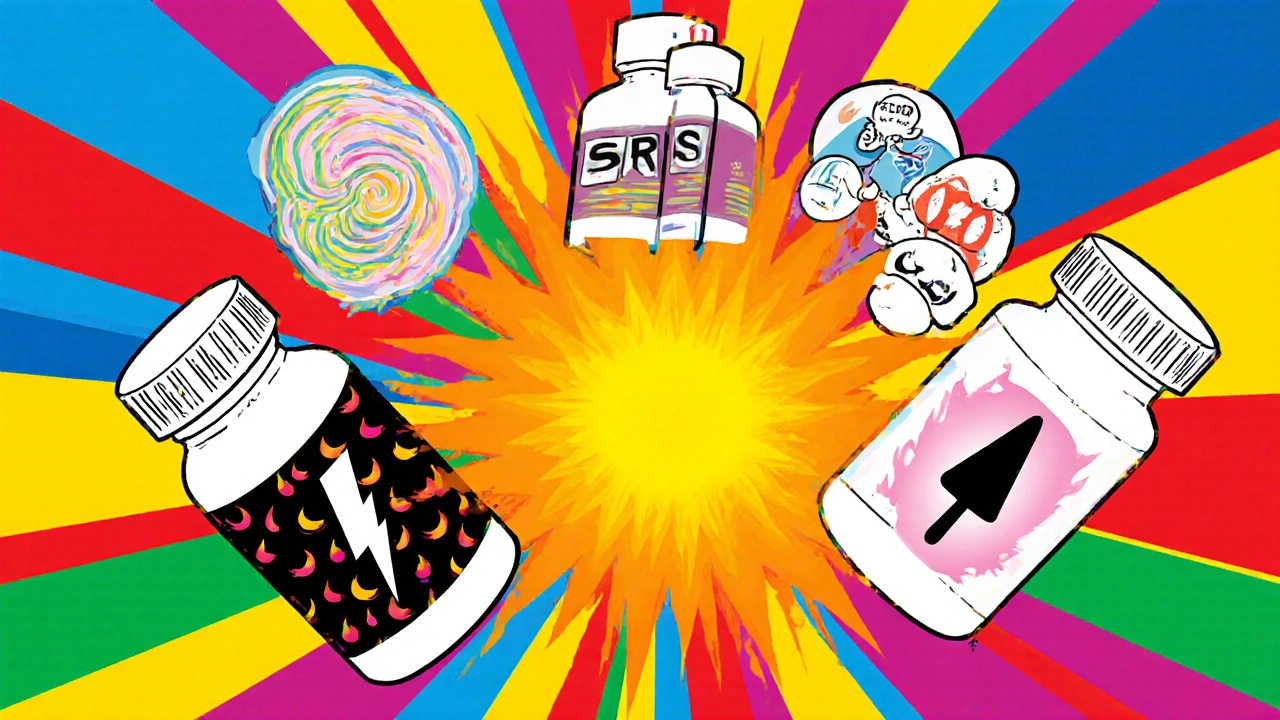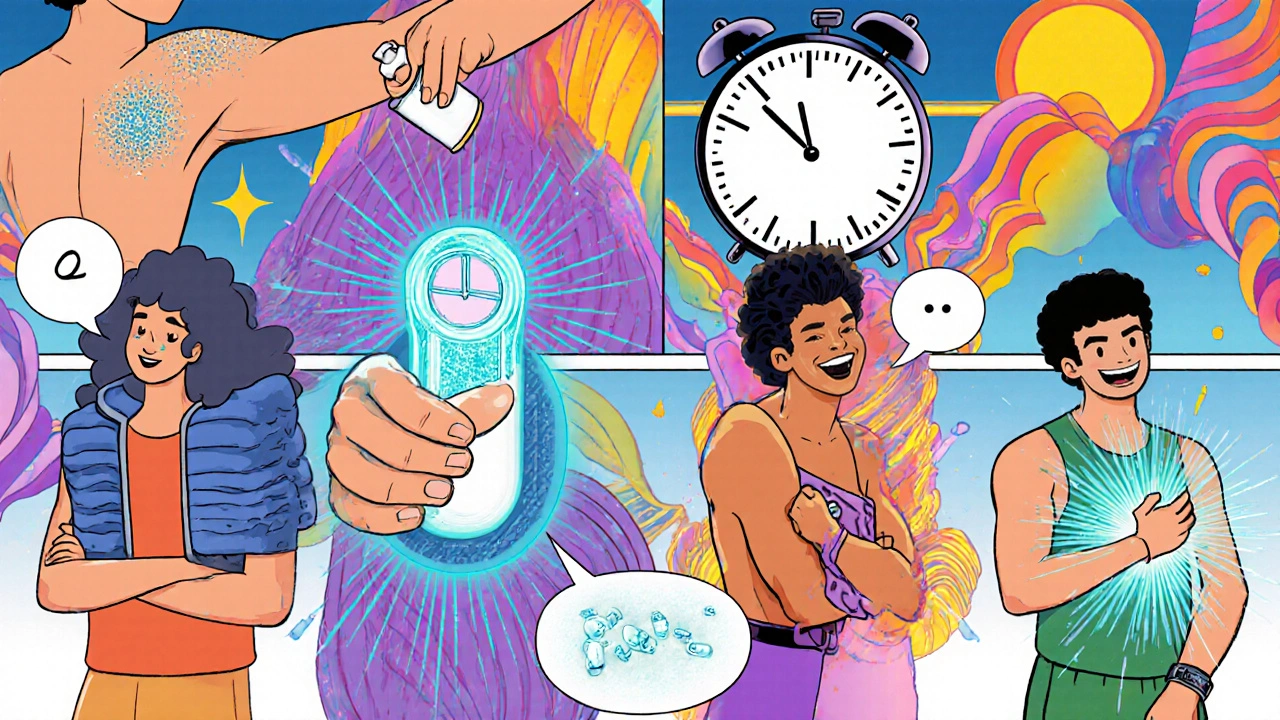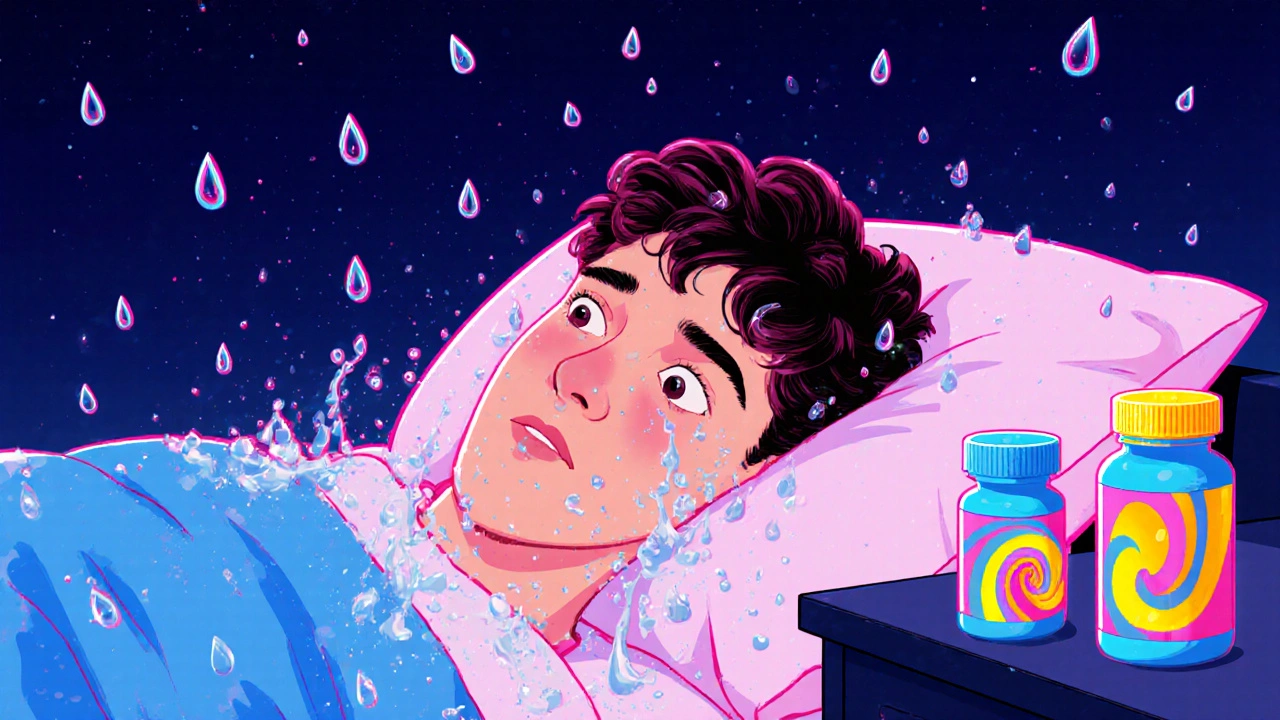25 Oct 2025
- 6 Comments
Medication Sweating Relief Calculator
This tool helps you determine which relief strategy is most likely to work for you based on your medication type, symptom severity, and personal preferences. Results are based on clinical evidence from the article.
Your Recommended Relief Strategy
Recommended Strategy
Why this works for you:
Other Options to Consider:
Medication‑induced sweating is a drug‑related side effect that causes excessive sweating and hot flashes, often disrupting sleep and daily activities. If you’ve ever wondered why a new prescription makes you break out in sweat at night, you’re not alone-about 15% of patients on high‑risk drugs report this problem.
Why the Sweat Happens: Basic Physiology
Medications can mess with the body’s thermoregulatory system in three main ways:
- Direct gland stimulation: Some drugs act on sweat glands or the sympathetic nervous system, prompting them to produce more sweat.
- Neurotransmitter disruption: Drugs that alter serotonin, norepinephrine, or dopamine levels can confuse the hypothalamus, the brain’s temperature‑control center.
- Hormonal shifts: Hormone‑blocking treatments (e.g., aromatase inhibitors) lower estrogen, which removes a key brake on heat‑sensing pathways.
Understanding which mechanism applies helps you pick the right relief strategy.
Big‑Ticket Culprits
More than 120 drugs across 15 therapeutic classes have sweating or hot flashes listed as adverse reactions. Below are the most frequently cited groups.
- Selective serotonin reuptake inhibitors (SSRIs) - e.g., escitalopram, sertraline. About 22% of users report sweating, often at night.
- Corticosteroids - e.g., prednisone. Trigger sweating in roughly 18% of patients.
- ADHD stimulants - e.g., Adderall, methylphenidate. Up to 35% of users experience excessive sweat.
- Opioid analgesics - e.g., oxycodone, morphine. Around 40% of patients notice night sweats.
- Hormone‑targeting breast cancer drugs - tamoxifen, anastrozole, exemestane. Hot flashes affect up to 78% of patients.
These numbers come from recent meta‑analyses and real‑world patient surveys, highlighting why the issue matters for both acute and chronic therapy.
How Sweating Impacts Treatment
When sweating becomes intolerable, patients often stop the medication. A 2021 adherence study found that 28.7% of people discontinued a needed drug because of sweating. The ripple effect includes disease flare‑ups, higher health‑care costs, and reduced quality of life.

Relief Strategies That Actually Work
Experts agree that the first step is to recognize the drug as the cause. From there, a tiered approach works best.
1. Topical Antiperspirants
Prescription‑strength antiperspirants with 12‑20% aluminum chloride hexahydrate are the gold standard. In a 2023 clinical review, 68% of users reported a noticeable drop in sweat after two weeks of nightly use.
Application tips:
- Dry the skin completely (no lotion).
- Apply a thin layer to the affected area before bed, 2-3 times per week.
- Start with a small amount to avoid skin irritation.
2. Timing Adjustments
Moving the dose to the morning can cut night sweats by half for many antidepressant users. Dr. Nilesh Shah’s 2022 study showed a 54.7% reduction when patients switched from evening to morning dosing.
3. Low‑Dose Anticholinergics
Glycopyrrolate 0.5-1 mg daily reduces sweat episodes by roughly 73% in severe cases. Monitor for dry mouth and constipation, which are the most common side effects.
4. Non‑Hormonal SSRIs for Hot Flashes
Paroxetine 10 mg daily has been proven to cut breast‑cancer‑related hot flashes by 62% without interfering with cancer treatment.
5. Lifestyle & Behavioral Tools
- Layered, moisture‑wicking clothing: Reddit users report 73% satisfaction when swapping cotton for technical fabrics.
- Bedroom cooling: Keeping the room under 65 °F (18 °C) helped 84% of BreastCancer.org forum members.
- Cognitive behavioral therapy (CBT): A 6‑8 week CBT program achieves 50‑60% symptom reduction for hot flashes.
6. Wearable Cooling Devices
Cooling vests like the Arctic Heat Cool Vest lower sweat episodes by 44% when worn for two peak‑heat hours each day. The device works by circulating chilled fluid through a lightweight mesh.
7. Emerging Tech
The SweatTech Smart Patch, currently in Phase 2 trials, detects early sweat spikes and activates a built‑in cooling element automatically. Early data suggest up to a 30% reduction in episode frequency.
Putting It All Together: A Practical Checklist
| Strategy | How It Works | Typical Efficacy | Key Considerations |
|---|---|---|---|
| Prescription antiperspirant | Aluminum chloride blocks sweat ducts | ≈68% reduction | Skin irritation; needs dry skin |
| Morning dose timing | Shifts peak drug levels away from sleep | ≈55% reduction in night sweats | May affect therapeutic effect timing |
| Glycopyrrolate | Anticholinergic blocks sweat signals | ≈73% reduction | Dry mouth, constipation |
| Paroxetine (for hot flashes) | Selective serotonin reuptake inhibition | ≈62% reduction | Potential drug interactions |
| CBT | Psychological coping & stress reduction | ≈55% reduction | Requires qualified therapist |
| Cooling vest | External temperature control | ≈44% reduction | Cost; limited wear time |

When to Call Your Doctor
If sweating is so severe that you’re losing electrolytes, experiencing dizziness, or you notice a new rash at the site of an antiperspirant, get medical help right away. Also, discuss any dose changes with your prescriber-abrupt stops can trigger withdrawal or disease flare‑ups.
Future Directions
Research is moving toward personalized risk profiling. A 2024 NIH study links the HLA‑DQB1 gene variant to a 3‑fold higher chance of medication‑induced sweating. In the next few years, clinicians may order a simple genetic test before prescribing high‑risk drugs.
Wearable tech, like the SweatTech Smart Patch, promises real‑time feedback and automatic cooling. If you’re an early adopter, keep an eye on trial results-the technology could become a standard add‑on for patients on opioids or SSRIs.
Key Takeaways
- About 15% of patients on certain drugs develop sweating or hot flashes.
- Common culprits include SSRIs, corticosteroids, ADHD stimulants, opioids, and hormone‑blocking cancer drugs.
- Topical antiperspirants, dose‑timing shifts, low‑dose anticholinergics, and non‑hormonal SSRIs are the most evidence‑based treatments.
- Lifestyle tweaks-cool rooms, moisture‑wicking fabrics, CBT-add up to a noticeable improvement.
- Emerging genetics and wearable cooling tech could soon make management even easier.
Which medications are most likely to cause night sweats?
SSRIs (like escitalopram), ADHD stimulants (Adderall, methylphenidate), opioids (oxycodone, morphine) and hormonal breast‑cancer drugs (tamoxifen, aromatase inhibitors) top the list, with prevalence ranging from 22% to over 70% depending on the class.
Can I keep taking my drug if I use an antiperspirant?
Yes, many patients find relief with prescription antiperspirants combined with non‑drug strategies. However, always discuss any new topical product with your prescriber, especially if you have skin sensitivity.
Is it safe to switch my SSRI dose to the morning?
For most SSRIs, moving the dose to the morning is safe and effective at cutting night sweats. Your doctor may adjust the total dose slightly to keep symptom control steady.
What side effects come with glycopyrrolate?
The main issues are dry mouth, constipation, and occasional blurred vision. Start at 0.5 mg and monitor; most patients tolerate it well.
Are cooling vests covered by insurance?
Coverage is limited-only about a third of commercial plans list them as reimbursable. Check your policy or ask your provider about a durable medical equipment (DME) exception.


Terell Moore
October 25, 2025Oh, bravo, another exhaustive catalog of sweat‑inducing meds-nothing the average Redditor hasn't already skimmed in a half‑hearted Google search. The piece dutifully lists SSRIs, steroids, stimulants, opioids, and the usual hormonal culprits, as if we needed a reminder that the pharma industry delights in side‑effects. I appreciate the meticulous citation of meta‑analyses, though the tone feels more like a corporate white paper than a compassionate patient guide. The recommended tiered approach-antiperspirant, dose timing, anticholinergics-reads like a checklist handed out at a pharmacist's desk. Yet the article skirts around the deeper issue: why we keep prescribing drugs with such predictable thermoregulatory fallout. A more critical look at alternative therapies would have been refreshing, but alas, we get the same safe‑play protocol. In short, solid data wrapped in sterile prose, perfect for a journal but lacking bedside empathy.
Amber Lintner
November 5, 2025Enough with the clinical lullaby! This so‑called “tiered approach” sounds like a bland buffet when patients are burning up at night. I mean, imagine lying in a cold sweat while the world pretends your discomfort is merely “manageable.” The article glosses over the emotional torment-those midnight panic attacks, the whispered apologies to loved ones, the absurdity of having to wear a cooling vest like some sci‑fi cosplay. It's high time we demand bold alternatives, not these watered‑down suggestions that leave you dabbing sweat with a napkin while the doctor smiles.
Lennox Anoff
November 16, 2025I find it morally indefensible that we continue to accept medication‑induced sweating as an inevitable side effect without demanding systemic change. The pharmaceutical industry profits from a cycle where patients are offered a drug, endure side effects, and then are handed a checklist of palliative measures that barely scratch the surface of their suffering. First, the article’s emphasis on topical antiperspirants, while useful, tacitly shifts responsibility onto the patient rather than questioning the drug’s necessity. Second, timing adjustments are presented as a simple fix, yet they ignore the pharmacokinetic intricacies that could compromise therapeutic efficacy. Third, the recommendation of low‑dose anticholinergics glosses over the fact that these agents introduce a cascade of their own anticholinergic burdens, especially in the elderly. Fourth, the so‑called “non‑hormonal SSRIs for hot flashes” claim to be a panacea, but they neglect the potential for serotonin syndrome when combined with existing regimens. Fifth, lifestyle tweaks such as moisture‑wicking fabrics are charming anecdotes, but they do not address the underlying iatrogenic disruption of homeostasis. Sixth, the cooling vest, while innovative, is a luxury item that many patients cannot afford, thereby widening the equity gap. Seventh, emerging technologies like the SweatTech Smart Patch remain experimental, and relying on them risks diverting attention from immediate, evidence‑based interventions. Moreover, the genetic risk profiling discussed in the future directions section raises profound ethical concerns about genetic discrimination and privacy. Additionally, the lack of robust patient‑reported outcome measures in clinical trials perpetuates the invisibility of this problem. We must also consider the psychological toll of constantly monitoring one’s body for sweat spikes, a burden that can exacerbate anxiety. Finally, the article’s call for clinicians to “discuss any dose changes” feels like a polite invitation to accept the status quo rather than a summons for a paradigm shift. In conclusion, while the strategies enumerated provide some relief, they collectively represent a band‑aid approach that fails to confront the deeper injustice of prescribing drugs without adequately safeguarding patients from predictable, debilitating side effects.
Abhinav B.
November 27, 2025Look, the real problem isn’t just the sweat, it’s that doctors keep prescribing these drugs without warning you about the heat‑up side effect. In India we see folks on steroids or painkillers who end up drenched at night and nobody even asks if they’re okay. You should demand a clear labal, not just “possible side effect.” Also, try using a simple cloth towel and a fan-cheap, but it works when the pharmacy can’t give you a fancy vest. Remember, you have the right to ask for an alternative if the sweating is ruining your life.
Lisa Woodcock
December 8, 2025I'm really sorry you’re dealing with night sweats on top of your medication regimen. It can feel isolating when your body feels like it’s on fire while everyone else is sleeping peacefully. One thing that helped me was setting a cool‑down routine: a warm shower before bed, followed by a quick change into breathable, moisture‑wicking pajamas. Pair that with a small fan directed at your feet, and you’ll notice a noticeable drop in sweat. If you haven’t already, talk to your doctor about trying the prescription‑strength antiperspirant; many patients see improvement within a week.
Sarah Keller
December 19, 2025Let’s cut to the chase: you don’t have to suffer in silence while a pill turns you into a human sauna. The evidence is crystal clear-topical antiperspirants, dose‑timing shifts, and low‑dose anticholinergics each shave a hefty chunk off sweat volume. I encourage you to bring this data to your prescriber, request a trial of glycopyrrolate, and demand a follow‑up to monitor side effects. If you hit resistance, remember you’re your own best advocate and there are community forums where patients share successful switches. Don’t settle for “just live with it”-fight for a regimen that respects your comfort.